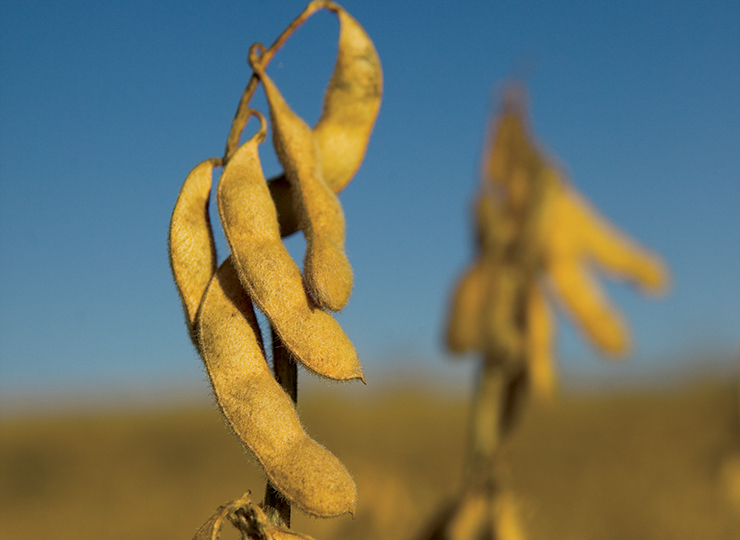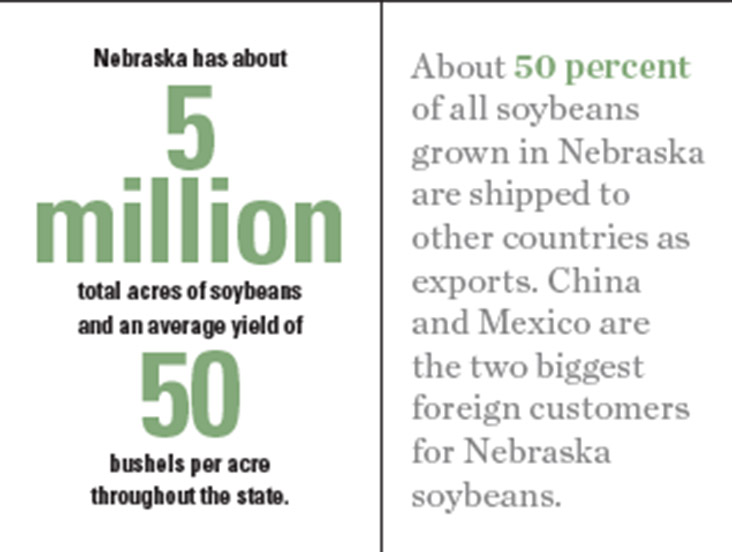Home > Nebraska > Nebraska Crops & Livestock > Nebraska Successful in High Soybean Production
Nebraska Successful in High Soybean Production

Soybeans play an important role in our daily lives, yet many Americans – and Nebraskans – have never seen them and couldn’t name two or three uses for this multipurpose crop. Did you know Nebraska ranks among the nation’s top five states for the production of soybeans, growing roughly 5 million acres of them each year?
“A large percentage of food products you see on grocery store shelves have some amount of soybeans in them,” says Victor Bohuslavsky, executive director of the Nebraska Soybean Board, which oversees the state’s soy industry. “The biggest use is in vegetable oils, with several of those products actually containing nearly 100 percent soybean oil used for cooking.”
Nebraska’s soybean industry ranks second only to corn in total crop production.
“We have good soil, natural irrigation and an ideal climate for growing soybeans, with 5 million total acres and an average yield of 50 bushels per acre throughout the state,” Bohuslavsky says. “Farmers in Nebraska can make a good living just by growing soybeans.”
One Bean, Two Products
When a soybean is picked and eventually processed, the bean gets crushed and becomes two separate products – soybean oil and soybean meal. The oil is consumed by humans through various products, and the meal is mostly turned into feed for animals.
“The oil portion makes up about 18 percent of the whole soybean, and meal comprises the other 82 percent,” Bohuslavsky says.
Soybean oil can be found in everyday products such as margarine, mayonnaise, crackers, baked breads and cookies. Many foods are packaged with soybean oil, including tuna.

The Multipurpose Soybean
Gregg Fujan is a soybean producer and a Nebraska-based director with the United Soybean Board, which makes decisions on how to spend farmer-contributed dollars toward new uses for soybeans. The dollars go to production research as well as domestic marketing and international marketing.
“Soybeans are now being used in products such as plastics, carpet backing and car seat foam. It is much more environmentally sound to use soybean oil rather than petroleum oil,” Fujan says. “The United Soybean Board is also funding research for improved genetics so soybeans can better combat human diseases.”
Research shows that soy food consumption can reduce a person’s risk of cardiovascular disease, obesity, osteoporosis, some cancers, prostate issues and Type 2 diabetes. As a result, scientists are studying how more soy protein can be somehow added to mainstream everyday foods to provide health benefits.
“Research is also occurring to eventually produce better agronomic soybeans that can increasingly withstand pests and plant disease, Fujan says. “In addition, there are efforts underway to utilize soybeans in the development of new biofuels. Soybeans will always be a major crop commodity in Nebraska. Our goal is to make soybeans more in demand around the world – even more than they already are.”

Exports to China and Mexico
About 50 percent of all soybeans grown in Nebraska are shipped to other countries as exports.
China and Mexico are the two biggest foreign customers for Nebraska soybeans, and Bohuslavsky says the state is poised to capture an even larger portion of the export market thanks to Nebraska’s strategic geographic location within the United States.
“States that are west of us don’t produce soybeans, so we are the closest soybean-producing state to the Pacific Northwest and their ocean-shipping lanes to China, the Far East and the Pacific Rim,” he says. “China grows corn well, but their climate and soil aren’t suitable for large amounts of soybean growth, so they import soybeans from Nebraska. They mix the soybean meal with corn for animal feed for their large poultry and swine operations. China has the largest swine inventory in the world.”
Bohuslavsky adds that the only way to keep growing the soybean industry in Nebraska is to increase exports.
“In the United States, the human food population is only so large and our population can only consume so much, so exporting is a key way to expand,” he says. “That’s why we are pleased that the Far East market continues to grow, plus export sales to Mexico continue to increase.”



